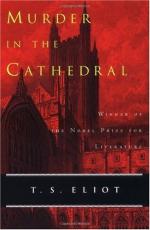|
This section contains 1,091 words (approx. 3 pages at 400 words per page) |

|
Tragedy
"Tragedy" as a dramatic form is usually defined as the story of a noble individual who struggles against himself or his fate in the face of almost certain defeat. Perhaps the ideal example of tragedy is Sophocles's Oedipus the King (5th century BC) in which Oedipus, the King of Thebes, attempts to cleanse his city against an evil that is plaguing it, only to learn that this evil is found in himself. Eliot's play does employ several classical tragic conventions, such as the use of a Chorus to comment on the action, the characters' speech written in verse, and a plot which culminates in the hero's death.
Thomas is a tragic figure in his larger-than-life passion and search for what can be done to solve the problem with which he is faced. Unlike many tragic heroes, however, Thomas's character harbors no "flaw" or (as Hamlet called it) "mole...
|
This section contains 1,091 words (approx. 3 pages at 400 words per page) |

|




